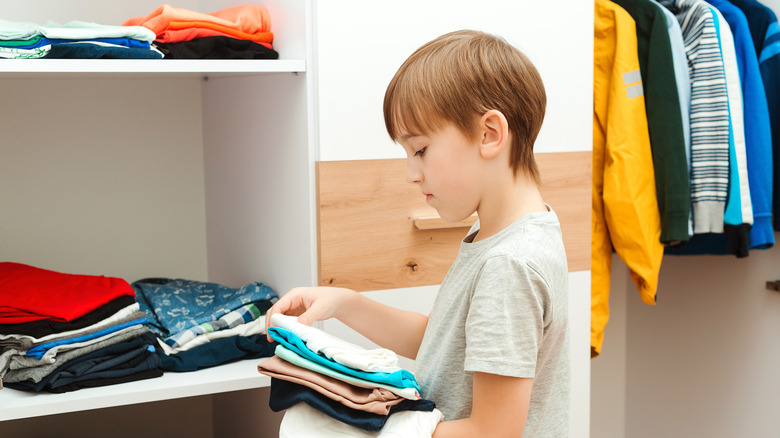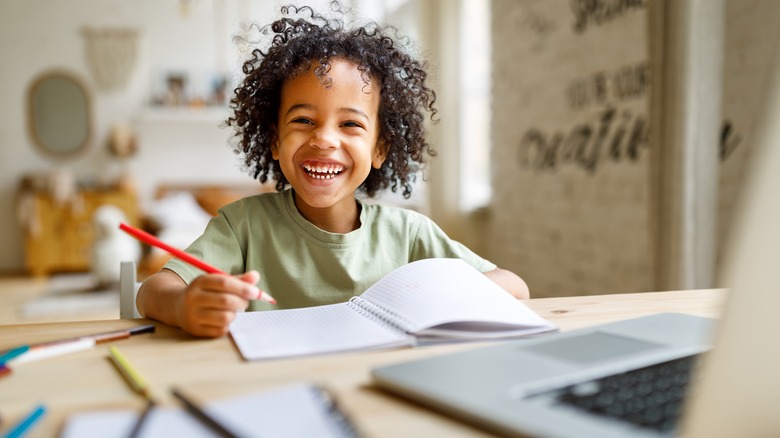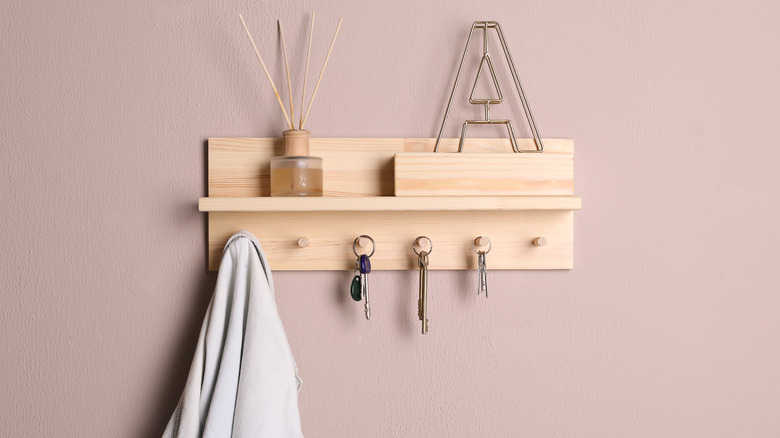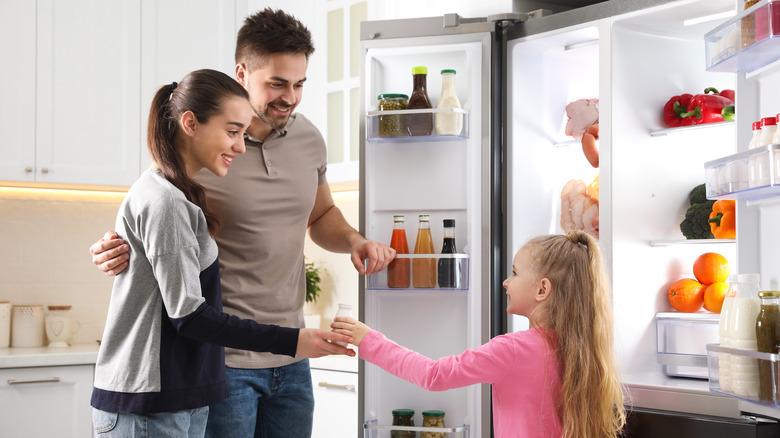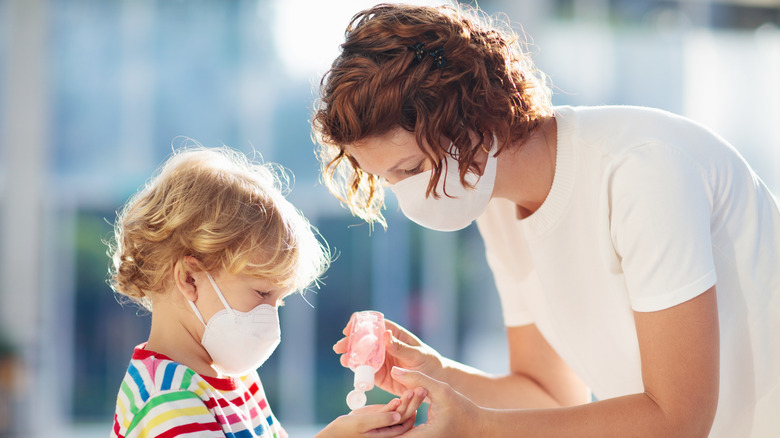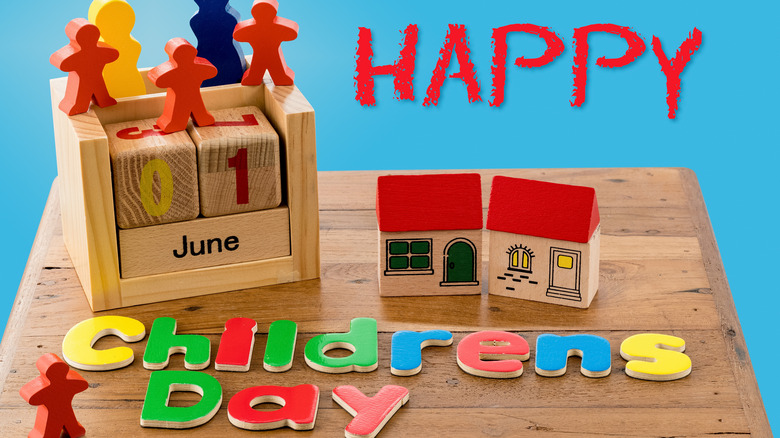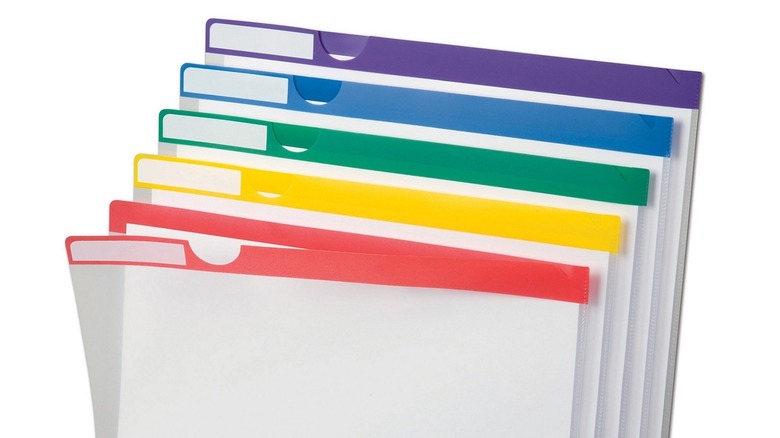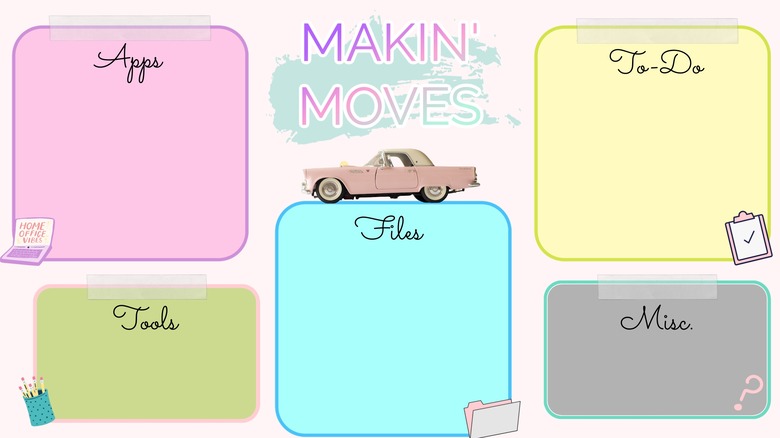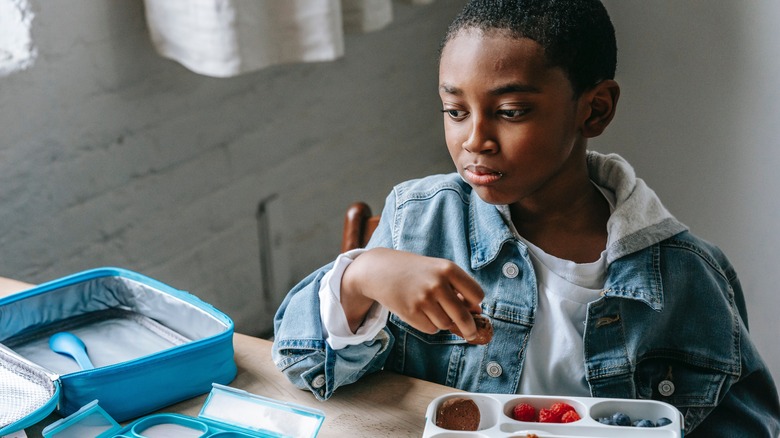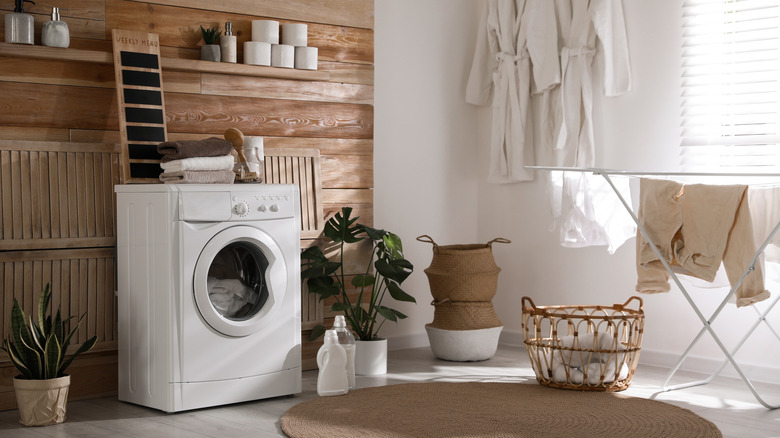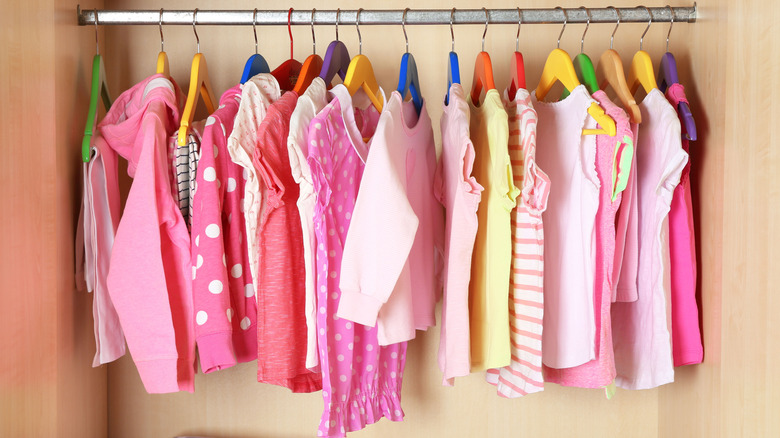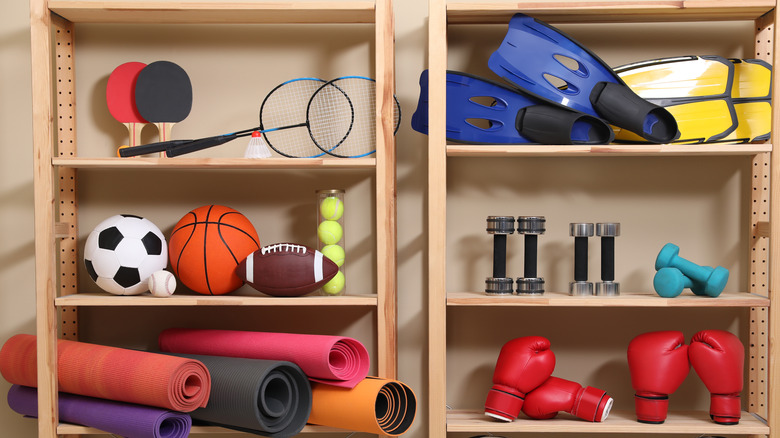Ways To Organize And Prepare For Back To School At Home
Parents and children alike are excited about summer vacation. It's a time to relax, enjoy the summer, and participate in fun outdoor activities. According to Lifeway, you can soak up the sun by going on a bike ride, visiting a local lake or swimming pool, or doing yard work. Of course, it's also a good idea to plan some time for relaxation and let your kids catch up on the sleep they missed during the school year.
Even though the summer features plenty of fun opportunities, don't overschedule children lest they feel anxious or stressed. Children need routine as far as waking up at set times each morning and eating breakfast to start their day. You can make each day a learning opportunity by reading novels with your kids or having them do a few math problems. This way, they'll be prepared academically to begin the new school year and transition from summer to fall. What about preparing the home for back to school? Here are ways to adjust your living space to make getting ready for school easy and stress-free.
Organize closets
Before children head back to school, organize bedroom closets to get rid of anything that doesn't fit and make room for new school clothes. Begin with the oldest or largest sized child to give hand-me-downs to the smaller children, per MomOf6. Keep things organized by placing clothes for donation in boxes. Hand-me-downs can stay in baskets until they pass to the siblings. Since it typically won't get cooler until about October, keep warm weather clothing on hand for those warm early autumn days.
Instead of having traditional closets with rods, make a reach-in closet with shelves so children can grab folded jeans and shirts (via Tailored Living). Organize shoes by type, color, and how much wear they get with shoe racks. Once children grow to be teenagers, they should have more say about how they want their closets to look. Be adventurous and play with colors, textures, and designs. For more organization, consider installing hooks inside for backpacks, coats, and purses. As a last step, throw away damaged items and store off-season clothing in the garage.
Add desk space
Children need to stay consistent with a homework schedule to turn in assignments on time and be responsible with their time management skills. When creating a proper homework space, ensure children aren't in an area with too much noise and stay away from television sets and tablets, per Scholastic. Children should have a desk space large enough to accommodate their homework, including textbooks, paper assignments, and laptops. Younger children may prefer to work on homework at the dining room table to have access to parental help or guidance from an older sibling when tough questions arise.
To make homework time easier, children should have school supplies close at hand. You can place containers or jars filled with markers and crayons on top of tables. Older children may need a graphing calculator nearby and a dictionary and thesaurus for advanced math and English subjects. A mini library is a great addition for young readers. Find books with genres children will enjoy, such as fantasy fiction or contemporary humor. These books can be situated with bookends or rest on a table.
Clear up the entryway
Clearing up a foyer is a priority for the back-to-school season. One way to organize this space is to arrange pull-out organizers on top of each other against a wall, per Julie Morgenstern. Doing this will allow books and school supplies to have a home. If you have trouble finding the car keys in the morning, look into installing magnetic wall-mounted containers on entryway walls. These containers can hold keys, lanyards, and earbuds.
A great way to add organization to this area is to add chalk panels and properly label winter gear (via Sunny Day Family). If there's enough room in the entryway, place these organizers on the top or bottom of a long table. Alternatively, place a wooden tray on the table to hold field trip permission slips and other papers that need adult signatures. Grab a few flat chalkboards from a craft or home decor store and use chalk to write out daily reminders. This way, no one forgets what they need for school or the day's activities.
Organize the refrigerator
Clean your refrigerator before children prepare to go back to school. One way to keep messes at a minimum is to have placemats on refrigerator shelves, per A Pretty Life. These can be taken out and cleaned easily when spills or messes occur. You can also cut the placemats to fit inside the refrigerator. Inside, there can be a drawer specifically made for fresh fruits and vegetables that have already been washed and prepped.
For children who pack their lunches for school, lunch materials should be in reach in the refrigerator. Label a container with lunch meats, cheese, and bread to make sandwiches. Keep breakfast items within reach as well. Children can grab yogurt, granola bars, and fruit to take on the go or to eat in the kitchen. Ice packs are also ideal because children can put them in their lunch bags to keep things cool. Check out grocery stores and other kitchenware stores to buy lunch bags and ice packs.
Get alarm clocks
The struggle to wake up in the morning is real, especially when children would rather sleep in or get up too early while their parents still feel sleepy. Why not buy an alarm clock? Get children excited by allowing them to pick one they like or wrap it up and give it to them as a present, per Toys For Kids Reviews. For children who turn off their alarms and go back to bed, parents can ensure their child's alarm is at a higher volume and placed at the opposite end of the room to help the child get up and turn it off.
For parents with children in preschool, it's best to ensure your child has an appropriate bedtime. Toddlers who are preschool-aged may need to go to bed earlier or later depending on when it's time to wake up for the day (via Dad Fixes Everything). Another idea for preschoolers or children still learning to tell time is to give them an alarm clock with symbols instead of numbers. Make it fun for children by having an award system when they wake up or go to bed on time.
Buy hand sanitizers
Since the outbreak of COVID-19, schools have taken strong precautions in ensuring children and staff are using hand sanitizer and socially distancing. When preparing for back to school, parents should stock up on pocket-sized hand sanitizers at local grocery stores. Set up a command station to have hand sanitizers and masks ready for children each day, per Macaroni Kid. You can set up the command station on kitchen counters or any solid surface area with room.
Another tip is to purchase colorful baskets and assign a color to each family member. Place masks inside a plastic bag inside the baskets and the preferred sanitary hand lotion or soap. You'll also want to buy a tray to hold cans of Lysol or disinfectant wipes for cleaning up the command station or for children who may need to bring these sanitary items to class. The handmade command station should have enough in stock for the rest of the school year.
Use calendars
Since children tend to have extracurricular activities and appointments that arise during the school year, parents should always keep calendars on hand. According to Dr. Rachel Kramer, visual calendars help children with planning and time management. Children learn to become more accountable when they recognize and remember specific upcoming events such as friends' birthday parties. Ask children questions to ensure they know the dates of their games and lessons. You can also use calendars to mark dates for family time, such as preparing special dinners and going to the pool together.
Another good tips is to buy a child-friendly calendar to help young children learn the days of the week (via learn2gether). After they know the days of the week, they should learn how to count to 30, as it's the number of the days in most months. When learning the names of the months, think up a catchy song to remember each one, or learn a few of the names for the time being. Young children should also know about the four seasons and different types of weather. Not only are they learning to read calendars, but it will also prepare them for school.
Have filing systems in place
Parents may feel guilty throwing school assignments and artwork away at the end of each year. How could this problem be fixed? One idea is for each school-aged child to have a file folder box filled with file folders, per Families With Grace. There should be about 14 file folders per grade until senior year, plus a few extra folders for the preschool years. You can buy labels and permanent markers to write the child's name on their label box. Ideas of what to keep in these school file folders include class photos, unique art projects, and anything displaying the child's physical growth, such as fingerprints and hand-printed artwork. Parents can hold onto paper play programs as keepsakes for future remembrance.
For older children in high school, having digital computer home folders may be the best way to contain schoolwork electronically (via Tidy Your Time). Create a root folder from the file explorer icon and select the option to make more folders, then label one electronic folder with the child's name. Create subset folders that list each main core subject, namely math, science, social studies, and English. The folders should contain scanned tests, quizzes, projects, and study guides. You can also store these folders in Google Drive. Feel free to get playful by making different colored folders and incorporating fun designs.
Update computers
Parents and children may struggle with maintaining order on their desktop computers when dealing with homework. To keep assignments and computer file icons in check, design a computer desktop work mat that looks like an everyday computer wallpaper screen, per Organized Classroom. You can download these school-based work mats for free or purchase one online, but there are ways to construct one without hassle.
PowerPoint is the perfect tool for making a schoolwork mat with a Mac or a Windows computer (via Custom Desktop Tutorial For School). Click Page Setup to adjust the appropriate size for the blank canvas. Next, click the Insert tab and choose some adjustable shapes. Go to the Insert tab to grab text boxes to label each shape. Feel free to get creative with clip art and labels if you're a fan of cute cartoons and snazzy pictures. After completing your work mat, save it as a JPEG to the desktop. You can import the work mat into iPhoto and right-click to change the computer screen background. Now you're ready to fill the mat with folders that contain assignments and more.
Clean up the bathrooms
Before back to school begins, bathrooms should be cleaned and organized. One way to get organized is to create designated laundry baskets for sweaty clothes, per Columbus Bath Design. Children can have baskets and trays for their toothbrushes, toothpaste, and towels to lessen confusion. A tip for parents with younger children is to have a basket of books near the bathtub to choose from when bathing a child. Find mesh storage bags at bath and home stores to place bathtub toys into when they're not currently in use. For additional storage, install corner shelves in the bathroom.
For families who have multiple children approaching high school age, enlarging counter space may allow the children to get ready together in the morning (via Colorado Tub Repair). Large counters can hold more toiletries and cosmetics, plus there's more room for electrical sockets for hairdryers and shavers. Another way to get over the school bathroom blues where everyone needs to rush in the morning is to finish a guest bathroom. This tip will allow children to go there if the main bathroom is getting crowded and time is running out.
Prepare school lunches
Parents should spend time clearing out old food in their pantries and refrigerators before school begins for the upcoming year. The first step is to remove old and expired food and wipe down the shelves in pantries and refrigerators, per 2020 Spaces. For children to access items they need for school lunches, designate a drawer solely for paper lunch bags, napkins, disposable utensils, and plastic containers. You can alleviate clutter and create more space by organizing kitchen items. Store cutting boards in wicker baskets and consider buying sleek swivel stools as an alternative to cumbersome kitchen chairs.
Another change to make before school begins is to have children help organize food in a cupboard by food group or color (via A Healthier Michigan). Keep inventory of needed school lunch and school project items like lunchboxes and muffin trays and have them nearby. You can plan for packed school lunches by having fruit and vegetables washed and cut up in plastic containers. Keeping healthy snacks on hand will encourage children to be mindful when packing school lunches.
Take care of the laundry room
Everyone will need to do more laundry once the back-to-school season starts. To prevent chaos, each child should have a laundry basket for putting away their clothes, per Adventure Mom. It may even be helpful to have a couple of laundry baskets for each child to clean school and sports uniforms separately. Don't get bummed out about misplaced socks. You can keep them in a mini basket in the laundry room to find matches in the future.
To prevent items from getting lost, install hooks to hold backpacks and jackets (via Painterati). You can also keep the floor clear using lockers and cubbies to stow away sports equipment needed for school. For the wintertime, gather baskets with mittens, gloves, scarves, and knitted hats to put on shelves for future use. Another way to jazz up your mudroom is by adding a full-length mirror to a wall for quick outfit checks. Children getting used to buttons and zippers may need a mirror to see what they're doing.
Create a dressing station for toddlers
Have a preschool-aged child who's learning how to get dressed by themselves? Set up a Montessori dressing station, per Montessori in Real Life. Ensure the child has enough closet space to change in their bedroom by constructing a clothing rack in the closet with small hangers for the child's clothes. The clothing rack should be the right height and not too tall. This tip will enable the child to grab what they need to wear for the day and make independent clothing choices.
An option to help the child dress is to add a step stool inside the closet for them to sit down and change. Have slip-on shoes and socks nearby for them to learn how to put them on themselves. It's also a good idea to place storage boxes under the clothing racks filled with pants and shirts for easy access. Keep a mirror up against one of the closet walls for the child to look at when getting changed. Doing so will allow them to make sure they're getting dressed correctly and teach them how to use laundry bins to put away their dirty clothes.
Make space to organize sports equipment
The start of the school year means it's time for fall sports. To break the hassle of finding the right equipment and uniforms for practice and games, create garage storage with cubbies from discarded furniture, per IHeart Organizing. To make your cubbies, measure out square pieces of wood with a ruler or tape measure. You can use a manual or electric saw to cut the pieces. Add color by mixing and matching complementary paint colors together. The outer layer of the cubbies can be yellow or bold shades of turquoise or green.
Another way to store sports equipment is to redo the garage, if necessary (via Designed to Dwell). Start by nailing slatted pieces of wood against a wall to hold lacrosse sticks and hockey sticks in place for the top and bottom. Grab about three bungee cords to hook onto two pieces of slatted wood installed on one side of the garage wall. Next, hook the three cords with one end on the top and one on the bottom of the slats to create a "U" shaped dome to hold sports balls.

